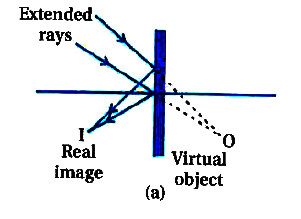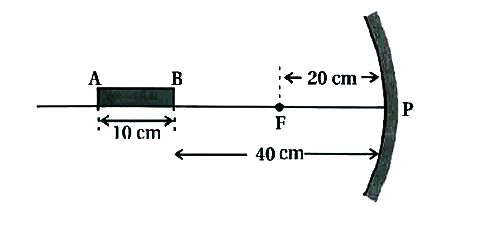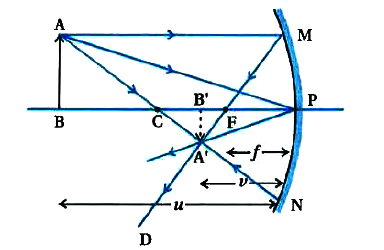Answer the following questions:
(a) You have learnt that plane and convex mirrors produce virtual images of objects. Can they produce real images under some circumstances? Explain. Solution in Gujrati
When object is placed behing plane of convex mirror, the rays coming out through reflection of mirror will intersect at a point in front of mirror, In other words, If objects in virtual , then by plane or convex mirror, real image can be obtained. Its ray diagram is as below.

Topper's Solved these Questions
- BOOK - KUMAR PRAKASHANCHAPTER - RAY OPTICS AND OPTICAL INSTRUMENTSEXERCISE - SECTION-B (NUMERICALS)(NUMERICAL FROM .DARPAN. BASED ON TEXTBOOK )12videos
RAY OPTICS AND OPTICAL INSTRUMENTS
- BOOK - KUMAR PRAKASHANCHAPTER - RAY OPTICS AND OPTICAL INSTRUMENTSEXERCISE - SECTION-C (NCERT EXEMPLAR SOLUTION) (MULTIPLE CHOICE QUESTIONS (MCQs))16videos
RAY OPTICS AND OPTICAL INSTRUMENTS
- BOOK - KUMAR PRAKASHANCHAPTER - RAY OPTICS AND OPTICAL INSTRUMENTSEXERCISE - SECTION-B (NUMERICALS)(NUMERICAL FROM TEXTUAL ILLUSTRATIONS)17videos
RAY OPTICS AND OPTICAL INSTRUMENTS
- BOOK - KUMAR PRAKASHANCHAPTER - MOVING CHARGES AND MAGNETISMEXERCISE - SECTION D (MCQs ASKED IN COMPETITIVE EXAMS)34videos
MOVING CHARGES AND MAGNETISM
- BOOK - KUMAR PRAKASHANCHAPTER - SAMPLE QUESTION PAPER EXERCISE - PART-B SECTION-C5videos
SAMPLE QUESTION PAPER
Similar Questions
As shown in the figure, a thin rod AB of length 10 cm is placed on the principal axis of a concave mirror such that it.s end B is at a distance of 40 cm from the mirror. If the focal length of the mirror is 20 cm, find the length of the image of the rod
 02:28View Solution
02:28View SolutionA ray of light incident at an angle θ on a refracting face of a prism emerges from the other face normally. If the angle of the prism is 5∘ and the prism is made of a material of refractive index 1.5, the angle of incidence is
06:20View SolutionSuppose that the lower half of the concave mirror.s reflecting surface as shown in figure is covered with an opaque (non-reflective) material. What effect will this have on the image of an object placed in front of the mirror ?
 02:26View Solution
02:26View SolutionElectric charge Q having mass M moves on a circular path of radius R with velocity →v, perpendicular to uniform magnetic field B. When a particle completes one revolution, work done by the field is _______
View SolutionTwo charges –q and +q are located at points (0, 0, –a) and (0, 0, a), respectively.
(a) What is the electrostatic potential at the points (0, 0, z) and (x, y, 0) ?
(b) Obtain the dependence of potential on the distance r of a point from the origin when r/a>>1 .
(c) How much work is done in moving a small test charge from the point (5,0,0) to (–7,0,0) along the x-axis? Does the answer change if the path of the test charge between the same points is not along the x-axis?03:29View Solutionसमतल दर्पण और उत्तल दर्पण में प्रतिबिम्ब सदैव आभासी बनता है। क्या कुछ परिस्थितियों में वे वास्तविक प्रतिबिम्ब बना सकते हैं ?
04:39View Solutionआपने सीखा है कि समतल तथा उत्तल दर्पण सदैव आभासी प्रतिबिम्ब बनाते हैं। क्या वे दर्पण किन्हीं परिस्थितियों में वास्तविक प्रतिबिम्ब बना सकते हैं ? स्पष्ट कीजिए।
01:35View Solutiona) You have learnt that plane and convex mirrors produce virtual images of objects. Can they produce real images under some circumstances ? Explain.
02:30View SolutionExplain under what conditions a real image of a virtual object and a virtual image of a virtual object are formed in a convex mirror.
01:53View SolutionYou have learned that plane and convex mirror produce virtual images of objects. Can they produce real image under some circumstances? Explain.
View SolutionWhat are the conditions under which a convex mirror can form a real image of a virtual object and virtual image of a virtual object? Explain.
View SolutionA : Plane and convex mirrors can produce real images of objects.
R : A plane of convex mirror can produce a real image if the object is virtual.04:30View SolutionUsing mirror formula, explain why does a convex mirror always produce a virtual image.
View SolutionAssertion : Concave mirror can produce virtual image of virtual object.
Reason : Convex mirror cannot form image of virtual object.03:01View SolutionAnswer the following questions:
(a) You have learnt that plane and convex mirrors produce virtual images of objects. Can they produce real images under some circumstances? Explain.02:35View Solution

